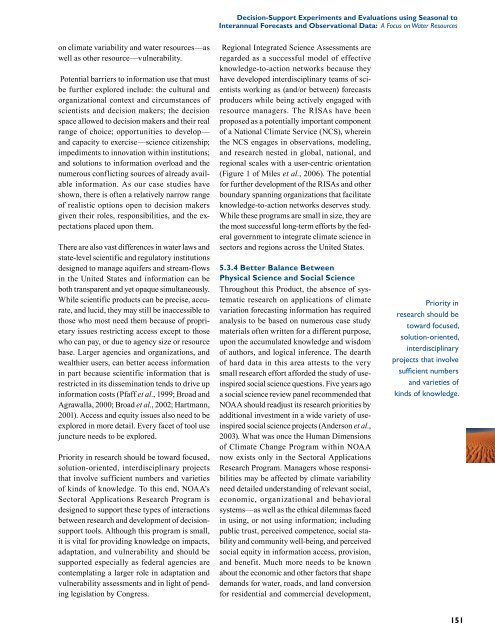Decision support experiments and evaluations using seasonal to ...
Decision support experiments and evaluations using seasonal to ...
Decision support experiments and evaluations using seasonal to ...
You also want an ePaper? Increase the reach of your titles
YUMPU automatically turns print PDFs into web optimized ePapers that Google loves.
on climate variability <strong>and</strong> water resources—as<br />
well as other resource—vulnerability.<br />
Potential barriers <strong>to</strong> information use that must<br />
be further explored include: the cultural <strong>and</strong><br />
organizational context <strong>and</strong> circumstances of<br />
scientists <strong>and</strong> decision makers; the decision<br />
space allowed <strong>to</strong> decision makers <strong>and</strong> their real<br />
range of choice; opportunities <strong>to</strong> develop—<br />
<strong>and</strong> capacity <strong>to</strong> exercise—science citizenship;<br />
impediments <strong>to</strong> innovation within institutions;<br />
<strong>and</strong> solutions <strong>to</strong> information overload <strong>and</strong> the<br />
numerous conflicting sources of already available<br />
information. As our case studies have<br />
shown, there is often a relatively narrow range<br />
of realistic options open <strong>to</strong> decision makers<br />
given their roles, responsibilities, <strong>and</strong> the expectations<br />
placed upon them.<br />
There are also vast differences in water laws <strong>and</strong><br />
state-level scientific <strong>and</strong> regula<strong>to</strong>ry institutions<br />
designed <strong>to</strong> manage aquifers <strong>and</strong> stream-flows<br />
in the United States <strong>and</strong> information can be<br />
both transparent <strong>and</strong> yet opaque simultaneously.<br />
While scientific products can be precise, accurate,<br />
<strong>and</strong> lucid, they may still be inaccessible <strong>to</strong><br />
those who most need them because of proprietary<br />
issues restricting access except <strong>to</strong> those<br />
who can pay, or due <strong>to</strong> agency size or resource<br />
base. Larger agencies <strong>and</strong> organizations, <strong>and</strong><br />
wealthier users, can better access information<br />
in part because scientific information that is<br />
restricted in its dissemination tends <strong>to</strong> drive up<br />
information costs (Pfaff et al., 1999; Broad <strong>and</strong><br />
Agrawalla, 2000; Broad et al., 2002; Hartmann,<br />
2001). Access <strong>and</strong> equity issues also need <strong>to</strong> be<br />
explored in more detail. Every facet of <strong>to</strong>ol use<br />
juncture needs <strong>to</strong> be explored.<br />
Priority in research should be <strong>to</strong>ward focused,<br />
solution-oriented, interdisciplinary projects<br />
that involve sufficient numbers <strong>and</strong> varieties<br />
of kinds of knowledge. To this end, NOAA’s<br />
Sec<strong>to</strong>ral Applications Research Program is<br />
designed <strong>to</strong> <strong>support</strong> these types of interactions<br />
between research <strong>and</strong> development of decision<strong>support</strong><br />
<strong>to</strong>ols. Although this program is small,<br />
it is vital for providing knowledge on impacts,<br />
adaptation, <strong>and</strong> vulnerability <strong>and</strong> should be<br />
<strong>support</strong>ed especially as federal agencies are<br />
contemplating a larger role in adaptation <strong>and</strong><br />
vulnerability assessments <strong>and</strong> in light of pending<br />
legislation by Congress.<br />
<strong>Decision</strong>-Support Experiments <strong>and</strong> Evaluations <strong>using</strong> Seasonal <strong>to</strong><br />
Interannual Forecasts <strong>and</strong> Observational Data: A Focus on Water Resources<br />
Regional Integrated Science Assessments are<br />
regarded as a successful model of effective<br />
knowledge-<strong>to</strong>-action networks because they<br />
have developed interdisciplinary teams of scientists<br />
working as (<strong>and</strong>/or between) forecasts<br />
producers while being actively engaged with<br />
resource managers. The RISAs have been<br />
proposed as a potentially important component<br />
of a National Climate Service (NCS), wherein<br />
the NCS engages in observations, modeling,<br />
<strong>and</strong> research nested in global, national, <strong>and</strong><br />
regional scales with a user-centric orientation<br />
(Figure 1 of Miles et al., 2006). The potential<br />
for further development of the RISAs <strong>and</strong> other<br />
boundary spanning organizations that facilitate<br />
knowledge-<strong>to</strong>-action networks deserves study.<br />
While these programs are small in size, they are<br />
the most successful long-term efforts by the federal<br />
government <strong>to</strong> integrate climate science in<br />
sec<strong>to</strong>rs <strong>and</strong> regions across the United States.<br />
5.3.4 Better Balance Between<br />
Physical Science <strong>and</strong> Social Science<br />
Throughout this Product, the absence of systematic<br />
research on applications of climate<br />
variation forecasting information has required<br />
analysis <strong>to</strong> be based on numerous case study<br />
materials often written for a different purpose,<br />
upon the accumulated knowledge <strong>and</strong> wisdom<br />
of authors, <strong>and</strong> logical inference. The dearth<br />
of hard data in this area attests <strong>to</strong> the very<br />
small research effort afforded the study of useinspired<br />
social science questions. Five years ago<br />
a social science review panel recommended that<br />
NOAA should readjust its research priorities by<br />
additional investment in a wide variety of useinspired<br />
social science projects (Anderson et al.,<br />
2003). What was once the Human Dimensions<br />
of Climate Change Program within NOAA<br />
now exists only in the Sec<strong>to</strong>ral Applications<br />
Research Program. Managers whose responsibilities<br />
may be affected by climate variability<br />
need detailed underst<strong>and</strong>ing of relevant social,<br />
economic, organizational <strong>and</strong> behavioral<br />
systems—as well as the ethical dilemmas faced<br />
in <strong>using</strong>, or not <strong>using</strong> information; including<br />
public trust, perceived competence, social stability<br />
<strong>and</strong> community well-being, <strong>and</strong> perceived<br />
social equity in information access, provision,<br />
<strong>and</strong> benefit. Much more needs <strong>to</strong> be known<br />
about the economic <strong>and</strong> other fac<strong>to</strong>rs that shape<br />
dem<strong>and</strong>s for water, roads, <strong>and</strong> l<strong>and</strong> conversion<br />
for residential <strong>and</strong> commercial development,<br />
Priority in<br />
research should be<br />
<strong>to</strong>ward focused,<br />
solution-oriented,<br />
interdisciplinary<br />
projects that involve<br />
sufficient numbers<br />
<strong>and</strong> varieties of<br />
kinds of knowledge.<br />
151




